Unit 4 Lesson 21 Eat a Donut and Turn Right 课件 2023-2024学年冀教版英语八年级上册 (共22张PPT)
文档属性
| 名称 | Unit 4 Lesson 21 Eat a Donut and Turn Right 课件 2023-2024学年冀教版英语八年级上册 (共22张PPT) | 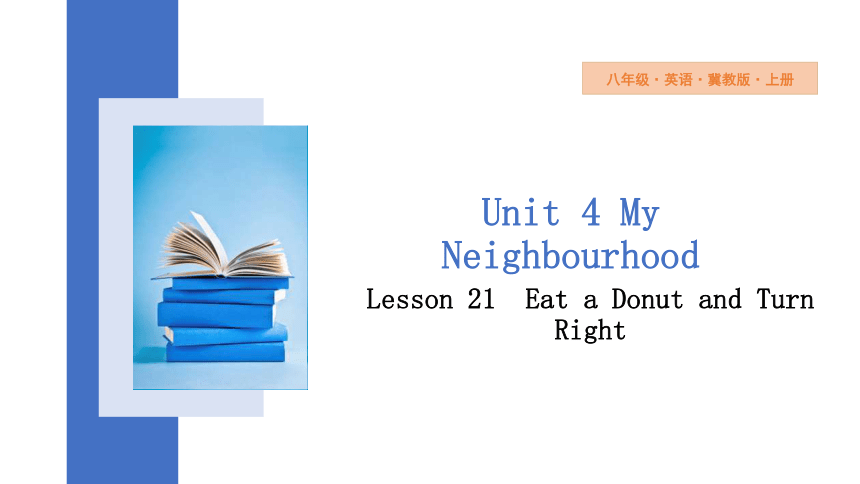 | |
| 格式 | pptx | ||
| 文件大小 | 694.4KB | ||
| 资源类型 | 教案 | ||
| 版本资源 | 冀教版 | ||
| 科目 | 英语 | ||
| 更新时间 | 2023-12-19 22:16:06 | ||
图片预览

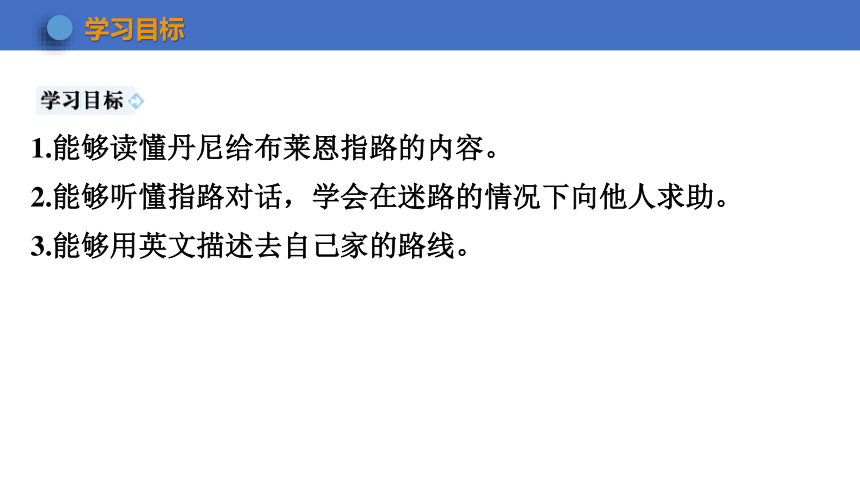
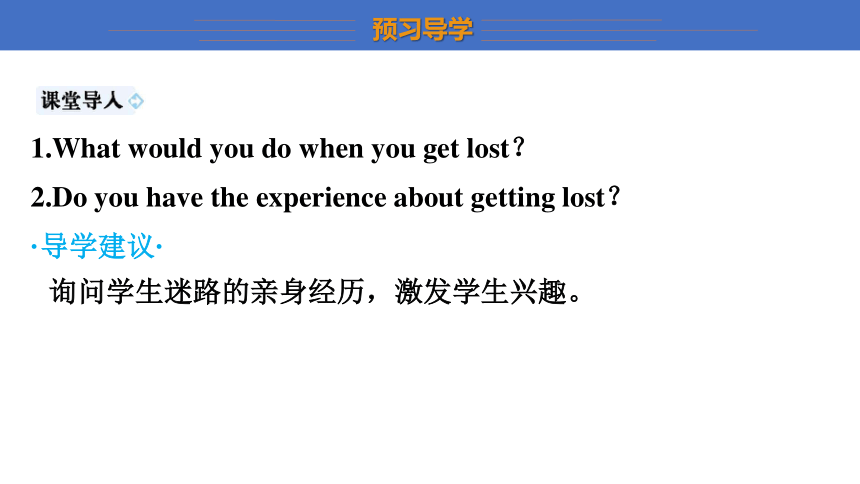
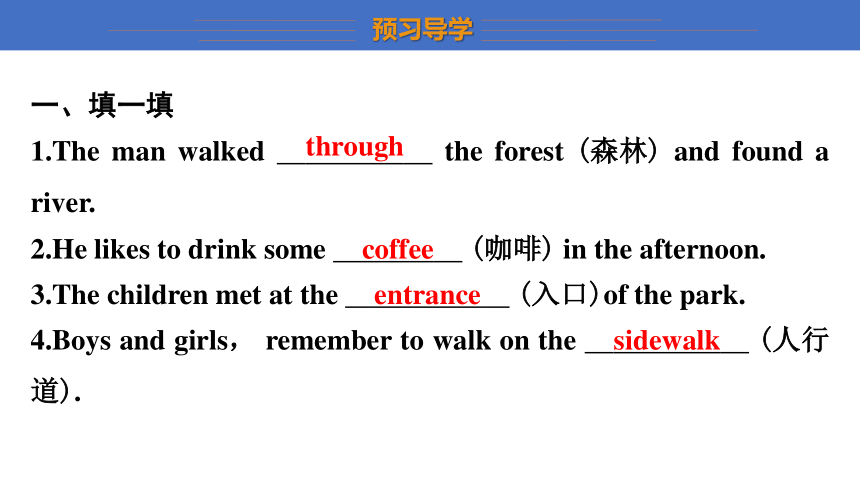
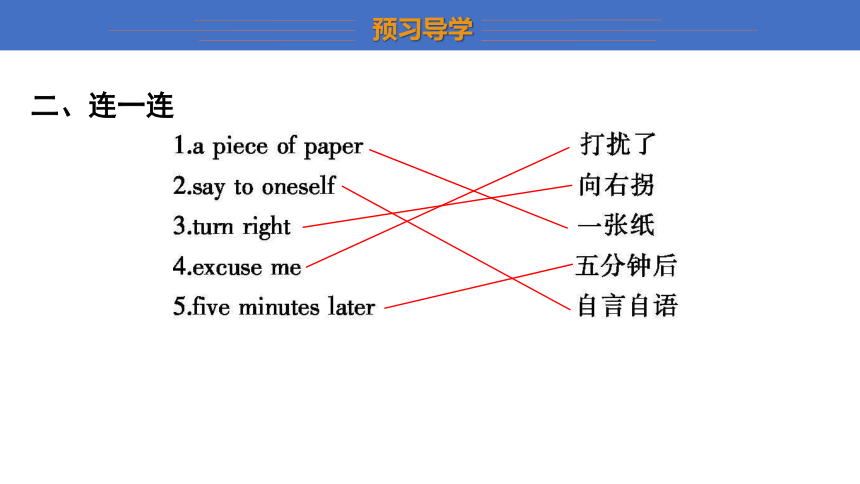
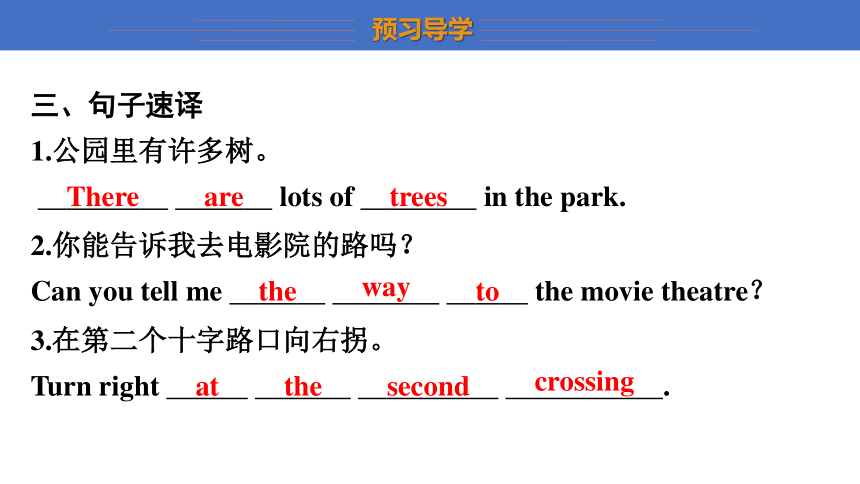



文档简介
(共22张PPT)
八年级·英语·冀教版·上册
Unit 4 My Neighbourhood
Lesson 21 Eat a Donut and Turn Right
1.能够读懂丹尼给布莱恩指路的内容。
2.能够听懂指路对话,学会在迷路的情况下向他人求助。
3.能够用英文描述去自己家的路线。
1.What would you do when you get lost?
2.Do you have the experience about getting lost?
·导学建议·
询问学生迷路的亲身经历,激发学生兴趣。
一、填一填
1.The man walked through the forest (森林) and found a river.
2.He likes to drink some coffee (咖啡) in the afternoon.
3.The children met at the entrance (入口)of the park.
4.Boys and girls, remember to walk on the sidewalk (人行道).
through
coffee
entrance
sidewalk
二、连一连
三、句子速译
1.公园里有许多树。
There are lots of trees in the park.
2.你能告诉我去电影院的路吗?
Can you tell me the way to the movie theatre?
3.在第二个十字路口向右拐。
Turn right at the second crossing .
There
are
trees
the
way
to
at
the
second
crossing
四、想一想
有哪些英文表达可用于问路?请写在下面。
Where is...?
How can I get to...?
Which is the way to...?
Could you show me the way to...?
Which bus can I take?
Where is...?
How can I get to...?
Which is the way to...?
Could you show me the way to...?
Which bus can I take?
·导学建议·
课前让学生准备好画地图时所需要的物品,为课上交流做好准备。
阅读理解
1.读课文,回答问题。
(1)Where is Brian?
Brian is on his way to meet Danny.
(2)What are Brian and Danny going to do?
They are going to see a movie.
(3)What does Brain do when he finds he is lost?
He asks a lady for help.
Brian is on his way to meet Danny.
They are going to see a movie.
He asks a lady for help.
2.读课文,判断正误。
(1)Brian and Danny are going to the downtown. ( T )
(2)Danny asks Brian to walk on the sidewalk. ( T )
(3)At last, Brain sees a cherry tree. ( F )
◎学法指导:先审题,再通读全文,然后查找文中相关信息,最后分析并锁定答案。
T
T
F
听力训练
1.听录音,模仿语音语词跟读课文,并清楚课本地图上的位置。
◎学法指导:听录音之前仔细阅读地图,弄清地图上建筑物的位置。
2.读课文,归纳并总结本课重点短语:
on one’s way, write out, on a piece of paper, the way to the movie theatre, walk down, cross the street, walk through, be straight ahead, walk on the sidewalk, start doing sth., at the second crossing, five minutes later, arrive at, the entrance of...
on one’s way, write out, on a piece of paper, the way to the
movie theatre, walk down, cross the street, walk through,
be straight ahead, walk on the sidewalk, start doing sth., at
the second crossing, five minutes later, arrive at, the
entrance of...
实践应用
1.请邀请你的同桌这个周末去你家。请为他/她画出并写出去你家的路线。
Now let me tell you the way to my house. You can take the No. 4 bus. Please get off at the fifth bus stop. Then walk along Xinhua Road and you can see a park. Go through the park, and you will see a bookshop across from the park. Walk across the road and turn right at the corner of the bookshop. Go straight along the road and turn left at the second turning. You will see my house. It’s next to the bank. You won’t miss it.
Now let me tell you the way to my house. You can take the
No. 4 bus. Please get off at the fifth bus stop. Then walk along
Xinhua Road and you can see a park. Go through the park,
and you will see a bookshop across from the park. Walk across
the road and turn right at the corner of the bookshop. Go
straight along the road and turn left at the second turning. You
will see my house. It’s next to the bank. You won’t miss it.
2.与同桌交流,确保路线清晰、准确。如果周末同桌有时间,就可以按照路线去找你。
◎学法指导:描述路线时可以参照任务驱动一。
Walk through the park.走过公园。
◎观察思考:
1.He could swim across the river when he was young. 他年轻的时候就能游过这条河。
2.The visitor drove through the city yesterday. 一名游客昨天开车穿过了这座城市。
through, across都是介词,意为“穿过,通过”。through强调从物体内部或一定空间范围内部穿过,其后常跟的名词有forest (森林),hole (洞),hall (大厅),window (窗户),tunnel (隧道)等。across指在某一空间从一端到另一端或呈十字交叉穿过,该动作在物体表面进行。其后常跟的名词有road、 river等。
◎用法总结:
选择through或across填空。
1.The sunlight was coming in through the window.
2.We walked across the street.
through
across
“This must be it,” Brian says to himself. “这一定就是了,”布莱恩对自己说。
◎观察思考:
1.She may be his sister.她可能是他的姐姐。
2.It can’t be my book. 它不可能是我的书。
◎用法总结:
must be 意为“一定是,肯定是”,表示肯定的推测,有把握。may be意为“可能是”,表示肯定的推测,把握不大。can’t be 意为“不可能是”,表示否定的推测,有把握。
根据汉语意思完成下列句子。
1.李明现在一定在教室。
Li Ming must be in the classroom now.
2.我的好朋友可能在家。
My good friend may be at home.
must
be
may
be
3.那不可能是我们的英语老师。我刚才看见他出去了。
It can’t be our English teacher. I saw him go out just now.
can’t
be
八年级·英语·冀教版·上册
Unit 4 My Neighbourhood
Lesson 21 Eat a Donut and Turn Right
1.能够读懂丹尼给布莱恩指路的内容。
2.能够听懂指路对话,学会在迷路的情况下向他人求助。
3.能够用英文描述去自己家的路线。
1.What would you do when you get lost?
2.Do you have the experience about getting lost?
·导学建议·
询问学生迷路的亲身经历,激发学生兴趣。
一、填一填
1.The man walked through the forest (森林) and found a river.
2.He likes to drink some coffee (咖啡) in the afternoon.
3.The children met at the entrance (入口)of the park.
4.Boys and girls, remember to walk on the sidewalk (人行道).
through
coffee
entrance
sidewalk
二、连一连
三、句子速译
1.公园里有许多树。
There are lots of trees in the park.
2.你能告诉我去电影院的路吗?
Can you tell me the way to the movie theatre?
3.在第二个十字路口向右拐。
Turn right at the second crossing .
There
are
trees
the
way
to
at
the
second
crossing
四、想一想
有哪些英文表达可用于问路?请写在下面。
Where is...?
How can I get to...?
Which is the way to...?
Could you show me the way to...?
Which bus can I take?
Where is...?
How can I get to...?
Which is the way to...?
Could you show me the way to...?
Which bus can I take?
·导学建议·
课前让学生准备好画地图时所需要的物品,为课上交流做好准备。
阅读理解
1.读课文,回答问题。
(1)Where is Brian?
Brian is on his way to meet Danny.
(2)What are Brian and Danny going to do?
They are going to see a movie.
(3)What does Brain do when he finds he is lost?
He asks a lady for help.
Brian is on his way to meet Danny.
They are going to see a movie.
He asks a lady for help.
2.读课文,判断正误。
(1)Brian and Danny are going to the downtown. ( T )
(2)Danny asks Brian to walk on the sidewalk. ( T )
(3)At last, Brain sees a cherry tree. ( F )
◎学法指导:先审题,再通读全文,然后查找文中相关信息,最后分析并锁定答案。
T
T
F
听力训练
1.听录音,模仿语音语词跟读课文,并清楚课本地图上的位置。
◎学法指导:听录音之前仔细阅读地图,弄清地图上建筑物的位置。
2.读课文,归纳并总结本课重点短语:
on one’s way, write out, on a piece of paper, the way to the movie theatre, walk down, cross the street, walk through, be straight ahead, walk on the sidewalk, start doing sth., at the second crossing, five minutes later, arrive at, the entrance of...
on one’s way, write out, on a piece of paper, the way to the
movie theatre, walk down, cross the street, walk through,
be straight ahead, walk on the sidewalk, start doing sth., at
the second crossing, five minutes later, arrive at, the
entrance of...
实践应用
1.请邀请你的同桌这个周末去你家。请为他/她画出并写出去你家的路线。
Now let me tell you the way to my house. You can take the No. 4 bus. Please get off at the fifth bus stop. Then walk along Xinhua Road and you can see a park. Go through the park, and you will see a bookshop across from the park. Walk across the road and turn right at the corner of the bookshop. Go straight along the road and turn left at the second turning. You will see my house. It’s next to the bank. You won’t miss it.
Now let me tell you the way to my house. You can take the
No. 4 bus. Please get off at the fifth bus stop. Then walk along
Xinhua Road and you can see a park. Go through the park,
and you will see a bookshop across from the park. Walk across
the road and turn right at the corner of the bookshop. Go
straight along the road and turn left at the second turning. You
will see my house. It’s next to the bank. You won’t miss it.
2.与同桌交流,确保路线清晰、准确。如果周末同桌有时间,就可以按照路线去找你。
◎学法指导:描述路线时可以参照任务驱动一。
Walk through the park.走过公园。
◎观察思考:
1.He could swim across the river when he was young. 他年轻的时候就能游过这条河。
2.The visitor drove through the city yesterday. 一名游客昨天开车穿过了这座城市。
through, across都是介词,意为“穿过,通过”。through强调从物体内部或一定空间范围内部穿过,其后常跟的名词有forest (森林),hole (洞),hall (大厅),window (窗户),tunnel (隧道)等。across指在某一空间从一端到另一端或呈十字交叉穿过,该动作在物体表面进行。其后常跟的名词有road、 river等。
◎用法总结:
选择through或across填空。
1.The sunlight was coming in through the window.
2.We walked across the street.
through
across
“This must be it,” Brian says to himself. “这一定就是了,”布莱恩对自己说。
◎观察思考:
1.She may be his sister.她可能是他的姐姐。
2.It can’t be my book. 它不可能是我的书。
◎用法总结:
must be 意为“一定是,肯定是”,表示肯定的推测,有把握。may be意为“可能是”,表示肯定的推测,把握不大。can’t be 意为“不可能是”,表示否定的推测,有把握。
根据汉语意思完成下列句子。
1.李明现在一定在教室。
Li Ming must be in the classroom now.
2.我的好朋友可能在家。
My good friend may be at home.
must
be
may
be
3.那不可能是我们的英语老师。我刚才看见他出去了。
It can’t be our English teacher. I saw him go out just now.
can’t
be
同课章节目录
- Unit 1 Me and My Class
- Lesson 1 Back to School!
- Lesson 2 Many Faces, One Picture
- Lesson 3 Getting to Know You!
- Lesson 4 Best Friends
- Lesson 5 Meet Ms. Liu
- Lesson 6 Jenny's Week
- Unit 2 My Favourite School Subject
- Lesson 7 Don't Be Late for Class!
- Lesson 8 E-mail Helpers!
- Lesson 9 I Don't Want to Miss Geography !
- Lesson 10 Looking for Lisa
- Lesson 11 Lily Learns about China !
- Lesson 12 Karen's Hair Stood Up!
- Unit Review
- Unit 3 Families Celebrate Togethe
- Lesson 13 I Love Autumn
- Lesson 14 Happy Memories
- Lesson 15 A Present for Li Ming!
- Lesson 16 Happy Thanksgiving!
- Lesson 17 Presents from Canada!
- Lesson 18 Li Ming's Birthday
- Unit Review
- Unit 4 My Neighbourhood
- Lesson 19 The Best Neighourhood
- Lesson 20 No Stopping!
- Lesson 21 Eat a Donut and Turn Right
- Lesson 22 I Like My Neighbourhood
- Lesson 23 People in My Neighbourhood
- Lesson 24 I Need a Map!
- Unit Review
- Unit 5 My Future
- Lesson 25 I Want to Be a Teacher!
- Lesson 26 What Will I Be ?
- Lesson 27 What's Your Advice?
- Lesson 28 Rich or Poor? It Doesn't Matter!
- Lesson 29 Our Ambitions and Dreams
- Lesson 30 A Famous Friend?
- Unit Review
- Unit 6 Go With Transportation !
- Lesson 31 How Do You Travel ?
- Lesson 32 Trains Go Faster !
- Lesson 33 Life on Wheels
- Lesson 34 Flying Donuts
- Lesson 35 Future Transportation
- Lesson 36 Clean Cars ?
- Unit Review
- Unit 7 Enjoy Your Hobby
- Lesson 37 What's Your Hobby ?
- Lesson 38 Hobbies Are Fun!
- Lesson 39 Danny's Hobby
- Lesson 40 What's Paul's Hobby?
- Lesson 41 Show and Tell!
- Lesson 42 The New Club
- Unit Review
- Unit 8 Celebrating Me
- Lesson 43 What Makes You Unique?
- Lesson 44 Georgia Plays Basketball
- Lesson 45 Be Yourself !
- Lesson 46 My Dream
- Lesson 47 I Made It !
- Lesson 48 Li Ming's Report
- Unit Review
